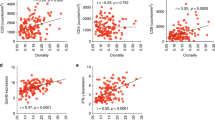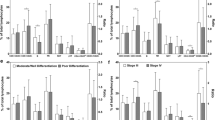Abstract
NSCLC arises in the complex environment of chronic inflammation. Depending on lung immune polarization, infiltrating immune cells may either promote or suppress tumor growth. Despite the importance of the immune microenvironment, current staging techniques for NSCLC do not take into consideration the immune milieu in which the neoplasms arise. T-cell subset content was compared between paired tumor-bearing and contralateral lungs, patient and control peripheral blood. The relationship between T-cell subset distribution and survival were evaluated. CD4 and CD8+ T cells were subsetted by CD45RA/CD27 and analyzed for expression of activation, adhesion, and homing markers. Strikingly, T-cell content was indistinguishable between lungs. Compared with peripheral blood, naïve CD4 and CD8 T cells were rare in BAL. CD4+ BAL T cells showed increased CD95 (higher apoptotic potential) and CD103 expression (epithelial adhesion), but decreased CD38 (activation) and CCR7 expression (lymph node homing). CD8+ BAL T cells showed increased CD103 expression and decreased CD28 expression (co-stimulation). Differences in CD28, CD95, and CCR7 expression were more pronounced within memory cells, while differences in CD4+ CD103 expression were more prominent in effector/memory cells. Of these populations, the absence of lung CD4 T cells with an effector-like phenotype (CD45RA+/CD27−) emerged as a predictor of favorable outcome. Patients with a low proportion (≤0.44%) had 90% 5-year survival (n = 10, median survival 2,343 days), compared with 0% (n = 9, median survival 516 days) of patients with a higher proportion. Further study is required to confirm this association prospectively and define the function of this subpopulation.




Similar content being viewed by others
References
Jemal A, Siegel R, Ward E, Hao Y, Xu J, Thun MJ (2009) Cancer statistics, 2009. CA Cancer J Clin 59:225–249
Mountain CF (1997) Revisions in the international system for staging lung cancer. Chest 111:1710–1718
Gastman BR, Atarashi Y, Reichert TE, Saito T, Balkir L, Rabinowich H, Whiteside TL (1999) Fas ligand is expressed on human squamous cell carcinomas of the head and neck, and it promotes apoptosis of T lymphocytes. Cancer Res 59:5356–5364
Whiteside TL (2010) Immune responses to malignancies. J Allergy Clin Immunol 125:S272–S283
Johansson M, Denardo DG, Coussens LM (2008) Polarized immune responses differentially regulate cancer development. Immunol Rev 222:145–154
Asselin-Paturel C, Echchakir H, Carayol G, Gay F, Opolon P, Grunenwald D, Chouaib S, Mami-Chouaib F (1998) Quantitative analysis of Th1, Th2 and TGF-&bgr;1 cytokine expression in tumor, TIL and PBL of non-small cell lung cancer patients. Int J Cancer 77:7–12
Huang M, Wang J, Lee P, Sharma S, Mao JT, Meissner H, Uyemura K, Modlin R, Wollman J, Dubinett SM (1995) Human non-small cell lung cancer cells express a type 2 cytokine pattern. Cancer Res 55:3847–3853
Allavena P, Sica A, Solinas G, Porta C, Mantovani A (2008) The inflammatory micro-environment in tumor progression: the role of tumor-associated macrophages. Crit Rev Oncol Hematol 66:1–9
Batra RK, Lin Y, Sharma S, Dohadwala M, Luo J, Pold M, Dubinett SM (2003) Non-small cell lung cancer-derived soluble mediators enhance apoptosis in activated T lymphocytes through an IκB kinase-dependent mechanism. Cancer Res 63:642–646
Houghton AM (2010) The paradox of tumor-associated neutrophils: fueling tumor growth with cytotoxic substances. Cell Cycle 9:1732–1737
Gao D, Nolan D, McDonnell K, Vahdat L, Benezra R, Altorki N, Mittal V (2009) Bone marrow-derived endothelial progenitor cells contribute to the angiogenic switch in tumor growth and metastatic progression. Biochimica et Biophysica Acta (BBA) Rev Cancer 1796:33–40
Woo EY, Chu CS, Goletz TJ, Schlienger K, Yeh H, Coukos G, Rubin SC, Kaiser LR, June CH (2001) Regulatory CD4(+)CD25(+) T cells in tumors from patients with early-stage non-small cell lung cancer and late-stage ovarian cancer. Cancer Res 61:4766–4772
Teng MW, Ngiow SF, von Scheidt B, McLaughlin N, Sparwasser T, Smyth MJ (2010) Conditional regulatory T-cell depletion releases adaptive immunity preventing carcinogenesis and suppressing established tumor growth. Cancer Res 70:7800–7809
Mandapathil M, Szczepanski MJ, Szajnik M, Ren J, Jackson EK, Johnson JT, Gorelik E, Lang S, Whiteside TL (2010) Adenosine and prostaglandin E2 cooperate in the suppression of immune responses mediated by adaptive regulatory T cells. J Biol Chem 285:27571–27580
Donnenberg VS, Luketich JD, Landreneau RJ, Popovich AM, Donnenberg AD (2004) Influx and apoptosis of activated effector memory T cells in both lungs of patients with unilateral non-small cell lung cancer (NSCLC). In: Journal of clinical oncology, 2004 ASCO annual meeting proceedings, vol 22, no. 14S (July 15 Supplement), New Orleans, LA, p 7373
Perussia B, Fanning V, Trinchieri G (1983) A human NK and K cell subset shares with cytotoxic T cells expression of the antigen recognized by antibody OKT8. J Immunol 131:223–231
Baars PA, Ribeiro Do Couto LM, Leusen JH, Hooibrink B, Kuijpers TW, Lens SM, van Lier RA (2000) Cytolytic mechanisms and expression of activation-regulating receptors on effector-type CD8+CD45RA+CD27− human T cells. J Immunol 165:1910–1917
Baars PA, Maurice MM, Rep M, Hooibrink B, van Lier RA (1995) Heterogeneity of the circulating human CD4+ T cell population. Further evidence that the CD4+CD45RA-CD27− T cell subset contains specialized primed T cells. J Immunol 154:17–25
Tomiyama H, Matsuda T, Takiguchi M (2002) Differentiation of human CD8+ T cells from a memory to memory/effector phenotype. J Immunol 168:5538–5550
De Jong R, Brouwer M, Hooibrink B, van der Pouw-Kraan T, Miedema F, van Lier RAW (1992) The CD27− subset of peripheral blood memory CD4+ lymphocytes contains functionally differentiated T lymphocytes that develop by persistent antigenic stimulation in vivo. Eur J Immunol 22:993–999
Hamann DR, Baars PA, Rep MHG, Hooibrink B, Kerkhof-Garde SR, Klein MR, van Lier RAW (1997) Phenotypic and functional separation of memory and effector human CD8+ T cells. J Exp Med 186:1407–1418
Appay V, van Lier RA, Sallusto F, Roederer M (2008) Phenotype and function of human T lymphocyte subsets: consensus and issues. Cytom A 73:975–983
Heriberto P-G, Dolores A-C, Hector F-V, Juan Jose M, Jose Sullivan L-G (2005) Effector, memory and naive CD8+ T cells in peripheral blood and pleural effusion from lung adenocarcinoma patients. Lung Cancer (Amsterdam, Netherlands) 47:361–371
Jenkins M, Taylor P, Norton S, Urdahl K (1991) CD28 delivers a costimulatory signal involved in antigen-specific IL-2 production by human T cells. J Immunol 147:2461–2466
Dhein J, Walczak H, Baumler C, Debatin K-M, Krammer PH (1995) Autocrine T-cell suicide mediated by APO-1/(Fas/CD95). Nature 373:438–441
Sallusto F, Lenig D, Forster R, Lipp M, Lanzavecchia A (1999) Two subsets of memory T lymphocytes with distinct homing potentials and effector functions. Nature 401:708–712
Mehta K, Shahid U, Malavasi F (1996) Human CD38, a cell-surface protein with multiple functions. FASEB J 10:1408–1417
Woods ML, Shimizu Y (2001) Signaling networks regulating {beta}1 integrin-mediated adhesion of T lymphocytes to extracellular matrix. J Leukoc Biol 69:874–880
Watt SM, Gschmeissner SE, Bates PA (1995) PECAM-1: its expression and function as a cell adhesion molecule on hemopoietic and endothelial cells. Leuk Lymphoma 17:229–244
Agace WW, Higgins JM, Sadasivan B, Brenner MB, Parker CM (2000) T-lymphocyte-epithelial-cell interactions: integrin alpha(E)(CD103)beta(7), LEEP-CAM and chemokines. Curr Opin Cell Biol 12:563–568
Rothlein R, Dustin M, Marlin S, Springer T (1986) A human intercellular adhesion molecule (ICAM-1) distinct from LFA-1. J Immunol 137:1270–1274
Mountain CF, Carr DT, Anderson WA (1974) A system for the clinical staging of lung cancer. Am J Roentgenol Radium Ther Nucl Med 120:130–138
Rao NA (1997) Mechanisms of inflammatory response in sympathetic ophthalmia and VKH syndrome. Eye (Lond) 11(Pt 2):213–216
Kuss I, Donnenberg AD, Gooding W, Whiteside TL (2003) Effector CD8+CD45RO-CD27-T cells have signalling defects in patients with squamous cell carcinoma of the head and neck. Br J Cancer 88:223–230
Takahashi T, Tagami T, Yamazaki S, Uede T, Shimizu J, Sakaguchi N, Mak TW, Sakaguchi S (2000) Immunologic self-tolerance maintained by CD25(+)CD4(+) regulatory T cells constitutively expressing cytotoxic T lymphocyte-associated antigen 4. J Exp Med 192:303–310
Rallón NI, López M, Soriano V, García-Samaniego J, Romero M, Labarga P, García-Gasco P, González-Lahoz J, Benito JM (2009) Level, phenotype and activation status of CD4+FoxP3+ regulatory T cells in patients chronically infected with human immunodeficiency virus and/or hepatitis C virus. Clin Exp Immunol 155:35–43
Mandapathil M, Lang S, Gorelik E, Whiteside TL (2009) Isolation of functional human regulatory T cells (Treg) from the peripheral blood based on the CD39 expression. J Immunol Methods 346:55–63
Takahashi K, Saito S, Kamamura Y, Katakawa M, Monden Y (2001) Prognostic value of CD4+ lymphocytes in pleural cavity of patients with non-small cell lung cancer. Thorax 56:639–642
Zhuang X, Xia X, Wang C, Gao F, Shan N, Zhang L, Zhang LA. High number of CD8+ T cells infiltrated in NSCLC Tissues is associated with a favorable prognosis. Appl Immunohistochem Mol Morphol 18:24–28
Hiraoka K, Miyamoto M, Cho Y, Suzuoki M, Oshikiri T, Nakakubo Y, Itoh T, Ohbuchi T, Kondo S, Katoh H (2006) Concurrent infiltration by CD8+ T cells and CD4+ T cells is a favourable prognostic factor in non-small-cell lung carcinoma. Br J Cancer 94:275–280
Al-Shibli KI, Donnem T, Al-Saad S, Persson M, Bremnes RM, Busund L-T (2008) Prognostic effect of epithelial and stromal lymphocyte infiltration in non-small cell lung cancer. Clin Cancer Res 14:5220–5227
Acknowledgments
The authors would like to thank Drs. Theresa Whiteside and Jill Siegfried for their careful reading and critique of this manuscript. This work was supported by the Heart Lung and Esophageal Institute of the University of Pittsburgh Medical Center, and the University of Pittsburgh Lung Cancer SPORE: NCI P50-CA90440.
Author information
Authors and Affiliations
Corresponding authors
Rights and permissions
About this article
Cite this article
Zikos, T.A., Donnenberg, A.D., Landreneau, R.J. et al. Lung T-cell subset composition at the time of surgical resection is a prognostic indicator in non-small cell lung cancer. Cancer Immunol Immunother 60, 819–827 (2011). https://doi.org/10.1007/s00262-011-0996-4
Received:
Accepted:
Published:
Issue Date:
DOI: https://doi.org/10.1007/s00262-011-0996-4




